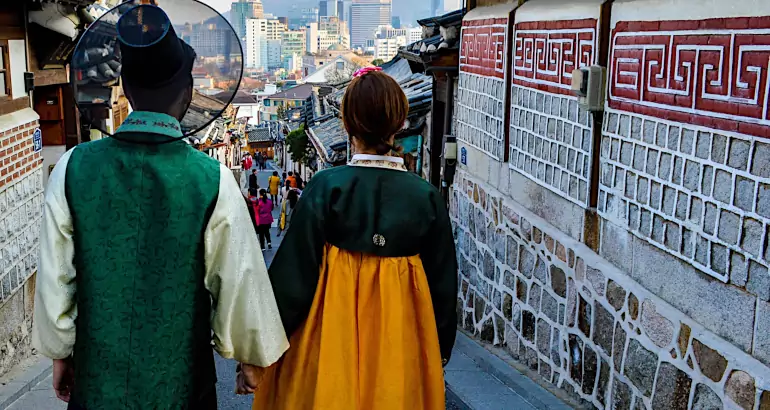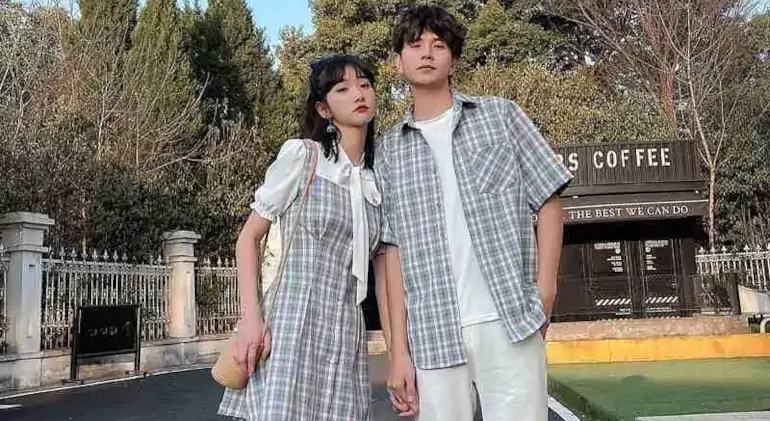30 Fascinating Facts about South Korea and Koreans

With its close proximity to tourism powerhouses like China or Japan, South Korea might have been overlooked for a considerable time. However, those days of being sidelined, forgotten by the rest of the world, are now behind us. In recent years, there has been a tremendous surge in global interest in this country, fueled in part by the flourishing of its arts (with music and cinema at the forefront), as well as its remarkable culture and the preservation of ancient traditions. In this post, we'll share 30 fascinating facts about South Korea to give you a better insight into the allure it holds for so many people, and we guarantee that more than one will leave you amazed!
- The Korean flag carries a profound meaning: against a backdrop of white symbolizing peace, a central circle represents the yin and yang. The yin (blue) embodies cold and darkness, while the yang (red) signifies warmth and light. Surrounding the yin-yang are four taeguks, each representing one of the four elements: water, air, earth, and fire.
- In South Korea, you age abruptly. Babies are considered one year old at birth, so when asked, "How old are you?" you'll need to add one year to your actual age.
- The word "Korea" translates to "land of high mountains and clear rivers."
- For Koreans, blood type holds significant importance. They believe each blood type corresponds to a distinct personality (and can even predict compatibility between couples!).
- Beauty masks are among the country's top-selling products, and they're not just popular among women: Korean men also embrace skincare and daily makeup routines. Korean society's obsession with appearance is evident, and Koreans' porcelain-like skin is often remarked upon.
- South Korea ranks among the world's leaders in cosmetic surgeries, with procedures like "eyelid surgery" to create double eyelids being particularly common. Surprisingly, it's one of the most requested gifts among young people upon reaching adulthood.
- While relations between South Korea and its northern neighbors remain strained (technically still at war), you can step foot on North Korean soil, albeit within the Korean Demilitarized Zone (DMZ). If interested, booking a tour is necessary.
- In South Korea, surveillance cameras are ubiquitous, creating an Orwellian atmosphere reminiscent of George Orwell's novel 1984. Though for security purposes, it's evident that the concept of privacy differs significantly.
- Approximately 90% of the seaweed used in cuisines worldwide is cultivated in South Korea.
- Koreans are notably superstitious: writing someone's name in red (associated with death) is taboo, and the number "4" is avoided whenever possible.
- The song "Gangnam Style" catapulted South Korea into the global spotlight in 2012, becoming the most-watched video worldwide that year. Its artist, PSY, dominated charts in dozens of countries, and today, there's even a statue commemorating the famous dance in Seoul's Gangnam district.
- This marked the rise of K-Pop as a global phenomenon, captivating millions of fans worldwide. During my visit to Seoul in March 2020, advertisements featuring members of groups like BTS or Blackpink were ubiquitous. Fast forward a few years, and I'm now a huge Blackpink fan, haha.
- If the global conquest of Korean music is evident, its cinema is equally impressive: the film "Parasite" clinched the Oscar for Best Picture, marking the first time a foreign production has achieved this honor. Haven't seen it yet? It's phenomenal!
- The traditional Korean attire is the hanbok, a delicate, colorful, and elegant dress. It comprises two parts: the top (jeogori), resembling a blouse, and the bottom (chima), a wide skirt. While there's a male version, it's not as visually striking or beautiful as its female counterpart. Traveling to Seoul, you can rent a hanbok (either here or in nearby shops near Bukchon Hanok Village, for example) and wander through the Royal Palaces like a native Korean (plus, dressing in hanbok often grants free entry!).
- Christianity (Catholicism and Protestantism) is the most popular religion in South Korea, with around 27% of the population adhering to it. About 15% identify as Buddhist, while the majority claims atheism.
- Similar to Japan, on February 14th (Valentine's Day), girls gift chocolates to their partners, receiving nothing in return. However, on March 14th, guys lavish their girlfriends with gifts (said to be at least three times the value of what they received).
- Did you know that South Korea boasts the most (and best) break dancers in the world? Check it out.
- In 1945, the country's literacy rate was around 22%. Today, however, 100% of Koreans are literate.
- Hangul is the language used in both Koreas, created by King Sejong in 1443, commemorated by a statue in Seoul today. Consisting of 40 letters (19 consonants and 21 vowels), Hangul has more interesting facts, which you can explore here.
- Military service is compulsory for all Korean men aged 18 to 28, lasting about two years. While it poses a challenge for many young people, they must adapt their lives to this obligation.
- This is one of the reasons why South Korea has the 6th highest suicide rate in the world. Among these, suicides among the elderly stand out, many of whom live below the poverty line and choose to end their lives rather than burden their families.
- Sannakji is an incredibly peculiar traditional Korean dish: it's live octopus. Yes, it's eaten alive. They chop it up and straight into the mouth! The truth is, it's a very risky meal, as the octopus, even when chopped, tends to stick its tentacles to the throat walls. If not chewed thoroughly before swallowing, there's a risk of choking to death. Phew, needless to say, we didn't try it.
- Although the most beloved national dish by Koreans is kimchi, which is essentially fermented Chinese cabbage in a spicy sauce (although there are over 100 different kimchi dishes). Another dish they go crazy for is fried chicken.
- When I first arrived at my hotel, I was surprised to see that the air conditioning didn't have the option of hot air, despite the cold weather outside! But then I understood the reason: in South Korea, the floors are warm. This system is called "ondol."
- That same night, I turned on the TV and saw a program with people singing with masks on. I found it very curious, and searching for information, I discovered that it was King of Mask Singer, a program that became so popular in Korea that they decided to export it to other countries like the United States, China, Germany, or Bulgaria, each with its adapted version.
- In South Korea, you can enjoy the fastest internet connection in the world, and practically 100% of the population has access to it.
- Not everything in South Korea is metropolises, skyscrapers, and neon lights: about 60% of the country is covered in forest. And good news for sea lovers: there are over 2,400 km of coastline!
- Taekwondo is a very popular martial art that originated about 2,000 years ago right here, in Korea.
- Koreans drink a lot: beer and especially soju, a super cheap rice liquor (a half-liter bottle costs around a euro).
- Jimjillbans are public baths where Koreans go to relax. They are like a spa where you can also sleep in common areas, eat, etc... However, if you want to take a relaxing bath, you must first shed all embarrassment: you have to go naked.
Related Posts:  Customs and Traditions: A Guide to Good Manners in South Korea
Customs and Traditions: A Guide to Good Manners in South Korea The Challenge of never having experienced a romantic relationship in South Korea
The Challenge of never having experienced a romantic relationship in South Korea Love in South Korea: Exploring Relationships and Dating Culture
Love in South Korea: Exploring Relationships and Dating Culture Quiz: Would You Be a Loser in South Korea?
Quiz: Would You Be a Loser in South Korea? Love in South Korea: Part 2 - Getting to Know Each Other
Love in South Korea: Part 2 - Getting to Know Each Other K-POP: The Iconic Music of the Korean Culture
K-POP: The Iconic Music of the Korean Culture Discovering South Korea: 8 Fascinating Tips for Your Journey
Discovering South Korea: 8 Fascinating Tips for Your Journey
 Customs and Traditions: A Guide to Good Manners in South Korea
Customs and Traditions: A Guide to Good Manners in South Korea The Challenge of never having experienced a romantic relationship in South Korea
The Challenge of never having experienced a romantic relationship in South Korea Love in South Korea: Exploring Relationships and Dating Culture
Love in South Korea: Exploring Relationships and Dating Culture Quiz: Would You Be a Loser in South Korea?
Quiz: Would You Be a Loser in South Korea? Love in South Korea: Part 2 - Getting to Know Each Other
Love in South Korea: Part 2 - Getting to Know Each Other K-POP: The Iconic Music of the Korean Culture
K-POP: The Iconic Music of the Korean Culture Discovering South Korea: 8 Fascinating Tips for Your Journey
Discovering South Korea: 8 Fascinating Tips for Your Journey Go up

Leave a Reply